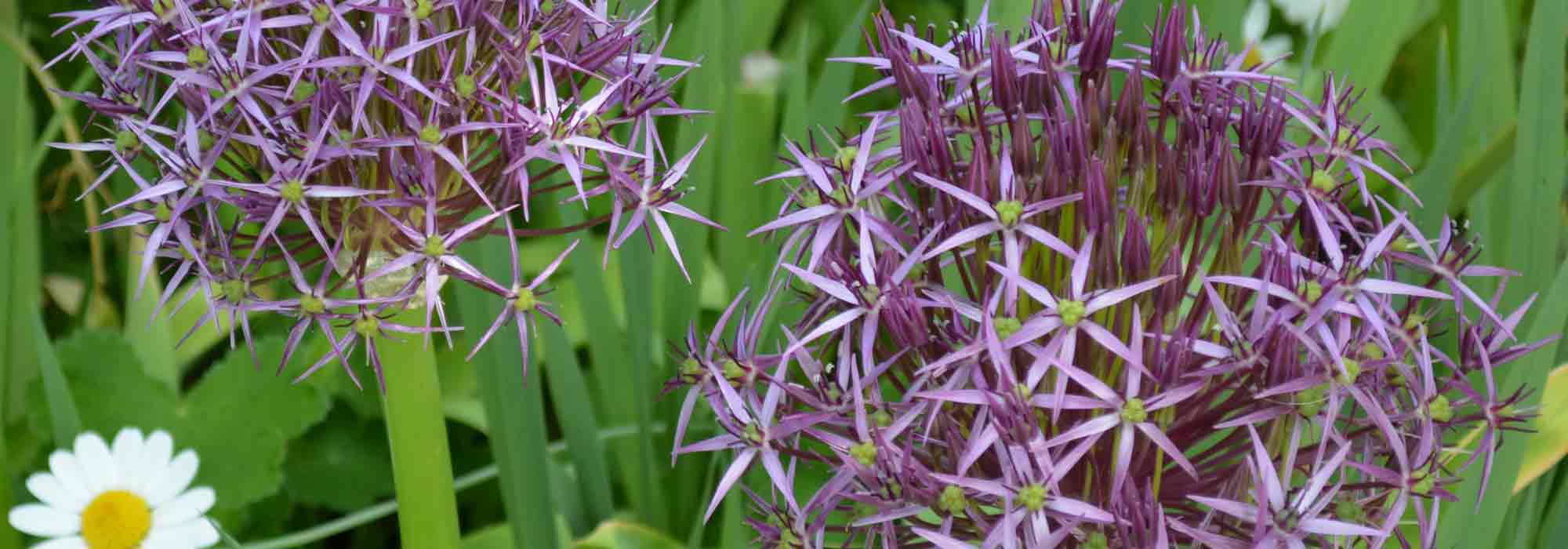
Allium: 9 successful pairing ideas
In mixed-border or in a naturalistic version
Contents
Alliums are essential in a natural garden or in a contemporary border. Grand and structural, they create graphic and colourful scenes in mixed borders, naturalistic beds, cottage gardens or contemporary meadow gardens thanks to their large inflorescences from late spring, adding striking verticality, relief, and whimsy.
Their tall, highly structural silhouettes balance volumes in more orderly beds and bring, even after their stems have faded, a breath of life to somewhat flat compositions. The habits, heights, and pure colours of these bulbous perennials lend themselves to all desires, whether in a stunning repetitive pattern in a flowerbed like natural waves or sparsely scattered in a border.
From Allium giganteum, Allium moly, Allium schubertii or Allium Gladiator including Allium ‘Purple Sensation’, they easily associate with all kinds of perennials from which their tall flowers majestically emerge. In monochrome purple, pink, blue or white, or in contrasting harmony blue/yellow, they joyfully combine with Oriental Poppies, Daisies, Agastaches, Echinops, delphiniums, Lupins, or Centauries.
They work wonders alongside hardy geraniums, Ornithogalums, Heucheras, a carpet of Hostas, or creeping bugle in sunny borders. Grasses and light-statured perennials like Alchemillas, valerian, or Gypsophila will add softness and movement in contrast to the vigorous habit of the alliums.
Ornamental Alliums generally bloom during the rose season, in late spring and early summer, they are excellent companions for roses, creating charming and romantic scenes together. The spherical and spectacular inflorescences reveal themselves in fresh and original bouquets while the dried flowers enter into very graphic dry floral arrangements.
Alliums are easy to pair, bringing grandeur and balance to borders, their colours are inspiring, let yourself be charmed by our 9 beautiful ideas for unusual or classic combinations.
To structure a somewhat flat flowerbed
The striking vertical dimension of alliums brings much-needed height and presence to the garden. The tallest varieties can reach up to 1.5 m in height, such as Allium giganteum, ‘Globemaster’, ‘Gladiator’, and ‘Purple Sensation’, which are best planted in the background to provide relief and lighten a somewhat flat border. Mixed with other spikes like those of lupins and veronicas, valerian, and planted among clumps of delphiniums, they will enliven these areas by creating graphic vertical accents and colour in opulent compositions. Vary the alliums for height effects: a few bulbs from the Bubble Gum collection will suffice to dress this type of border throughout the summer and into early autumn.
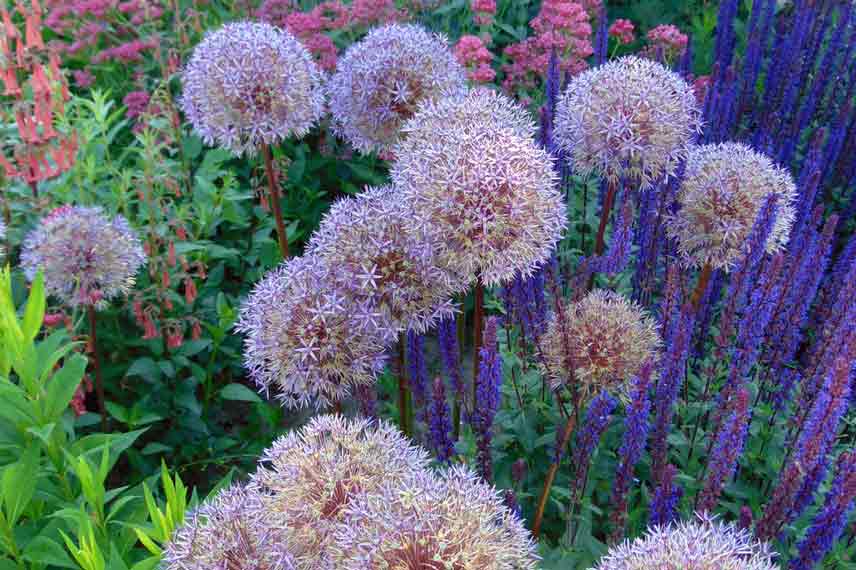
Allium ‘Globemaster’ alongside sage nemorosa, valerian, and Phygelius in a border in early summer
Read also
Planting alliumsIn full sun rockery
Alliums adapt well to stony and dry soils. The Allium karataviense, with its low habit, is a good choice for a rock or gravel garden where it can emerge from a tapetum of ground cover plants like Acaena, bugle plants, or alongside the succulent leaves of sedums.
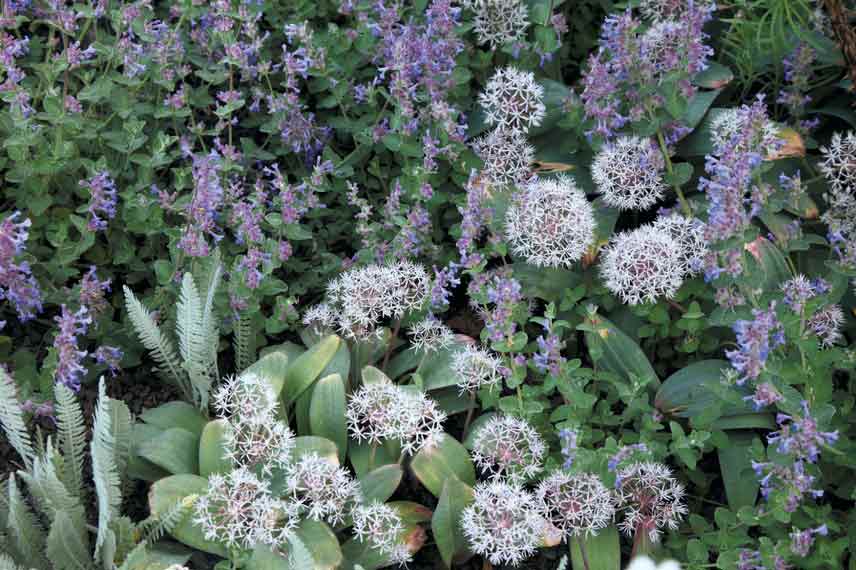
Allium karataviense Ivory Queen alongside Nepeta faassenii ‘Six Hill Giant’ (Photo: GAP Photo /Martin Staffler)
Discover other Allium
View all →Available in 2 sizes
Available in 0 sizes
Available in 1 sizes
Available in 0 sizes
Available in 2 sizes
Available in 1 sizes
Available in 1 sizes
Available in 1 sizes
Available in 2 sizes
To crown a naturalistic corner
Large alliums create displays that are as exuberant as they are ephemeral in contemporary meadows and natural gardens. Plant allium bulbs in clumps among robust and very hardy perennials that grow on their own, returning each year more opulent and floriferous. Another advantage is that they cleverly hide the foliage of alliums, which quickly withers after flowering. The leaves of a Love-in-a-Mist, for example, are perfect for concealing the faded foliage of garlic and once dry, the nigella seed pods will mingle with the dry heads of the alliums, in a very ornamental association until autumn.
Organise a clever mix of peonies, Oriental poppies, cornflowers, veronicas, campanulate, large bearded irises, columbines, lupins…
In this spirit, Allium sphaerocephalon with its small, tightly packed garnet flower pom-poms planted in very large quantities will find a perfect companion in Eryngium giganteum or Giant Sea Holly.
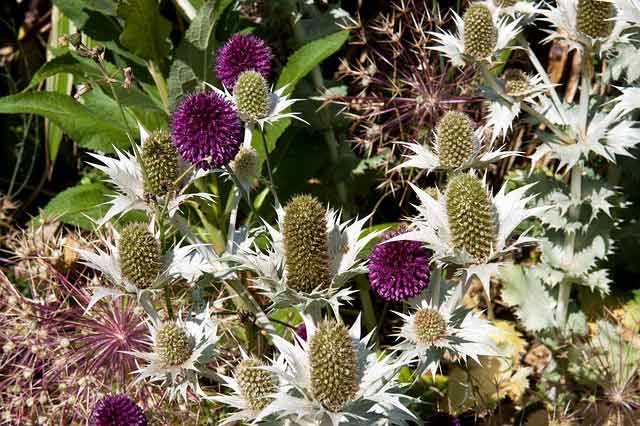
Allium sphaerocephalon begins its flowering amidst a clump of Eryngium giganteum while the faded flowers of Allium christophii contrast beautifully with this lovely duo.
Fantasy in a sunny mixed border
Composed of a wide diversity of perennial plants, the mixed border is typical of English gardens. In a sunny flowerbed, alliums with their strong presence add character, especially when used in a repetitive pattern. Set against a backdrop of bush roses or shrub peonies, they create a floriferous and abundant display. The low and medium varieties Allium sikkimense, Allium senescens subsp. montanum or Allium karataviense will suit narrow flowerbeds well.
The taller alliums Allium macleanii or elatum, Allium stipitatum ‘White Giant’ are breathtaking at the back of a border, blooming above the surrounding foliage. Pair them with other perennials such as campanulate flowers, hardy geraniums, foxgloves, Oriental poppies, lupins, Echinops, delphiniums, steppe lilies, or with bulbous plants like tulips.
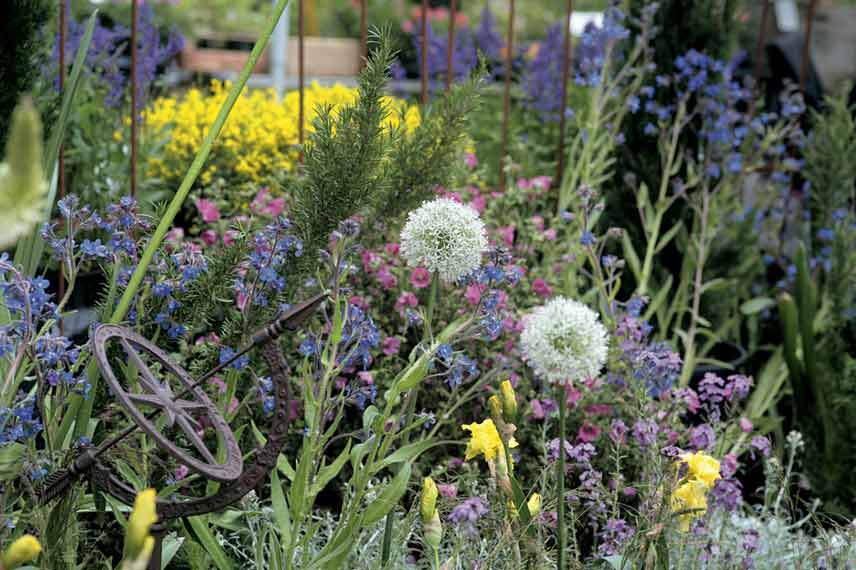
Allium ‘White Giant’ alongside Anchusa azurea Loddon Royalist and rosemary in a Mediterranean-inspired border.
Play with contrasts using grasses
Upright stems and the well-defined flowers of alliums introduce strong accents and enhance by contrast the airy aspect of grasses in a border. Plant alliums in groups of 3 or 5, tucking them between ornamental grasses such as Stipa tenuifolia or Carex. They will balance the somewhat strict habit of an Allium ‘Ambassador’, for example, bringing movement and especially a lovely lightness to a naturalistic scene.
Drowned in the grasses, the flowers of alliums contrast beautifully to form a charming duo in a dry garden.
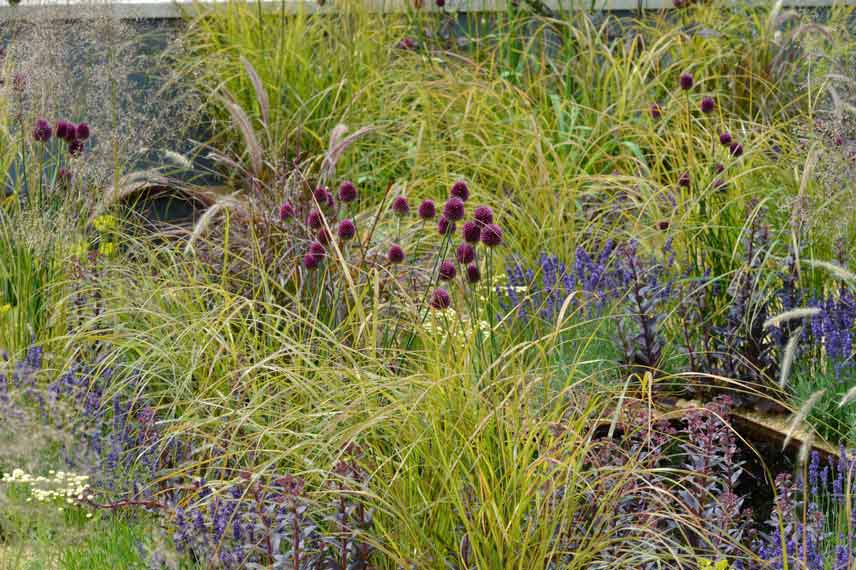
Allium sphaerocephalon emerges from the tufts of Stipa arundinacea, Lavenders, and Sedums (Photo: MAP / Nathalie Pasquel)
Tone on tone
Alliums are among the most beautiful pinks and purples in the garden. To see life in pink as spring comes to an end, plant some clumps of pink-flowered lupins in a very sunny corner of the garden, along with yarrow, Agastaches, large-flowered pink centauries, Stachys officinalis ‘Pink Cotton Candy’, and the large starry heads of Allium christophii or Allium ‘Early Emperor’ and Allium ‘Red Eye’.
In a summer bed fading in these harmonious shades of pink-purple, the globes of Allium ‘Miami’ will provide a contrasting shape to the flowers of late tulips ‘Silver Parrot’ or ‘Angélique’.
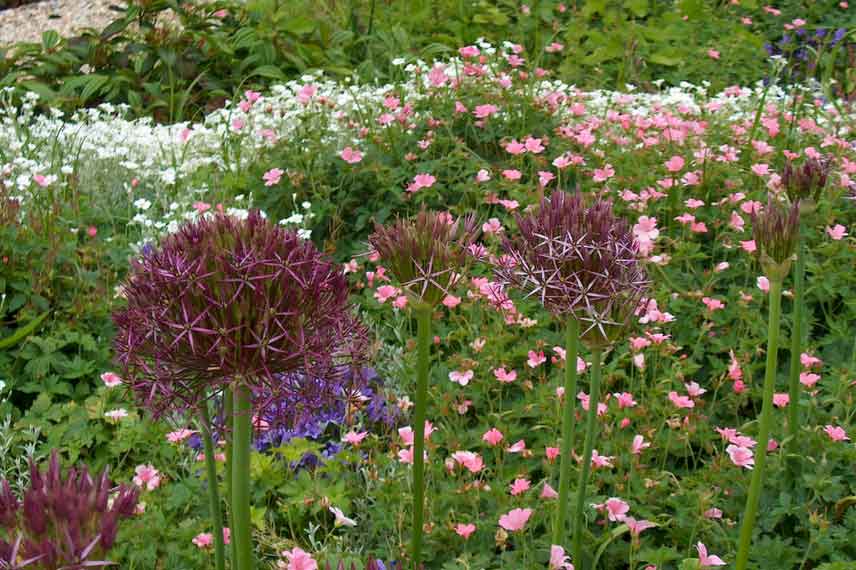
The large starry heads of Allium christophii in the foreground of an ocean of hardy geraniums endressii
Yellow/Purple-Blue: A Striking Combination
Installed in front of a curtain of foliage or acid green-yellow flowers, alliums provide a magnificent display that renews itself each year with almost no care. Plant Allium caeruleum in groups of 5 among yellow tulips, golden hop, or yellow brooms. The later-flowering allium ‘Summer Drummer’ will pair beautifully with Achilleas ‘Moonshine’ and Euphorbias.
Their intense hues will contrast with the powerful yellow foliage of Robinia pseudoacacia and Philadelphus coronarius ‘Aureus’ or the garden mock orange.
The Allium moly with its golden yellow flowers will be perfect at the front of a flower bed alongside small blue hardy geraniums, deep purple violas, late-flowering tulips (‘Black Hero’, ‘Blue Diamond’), blue centauries, and Eryngiums.
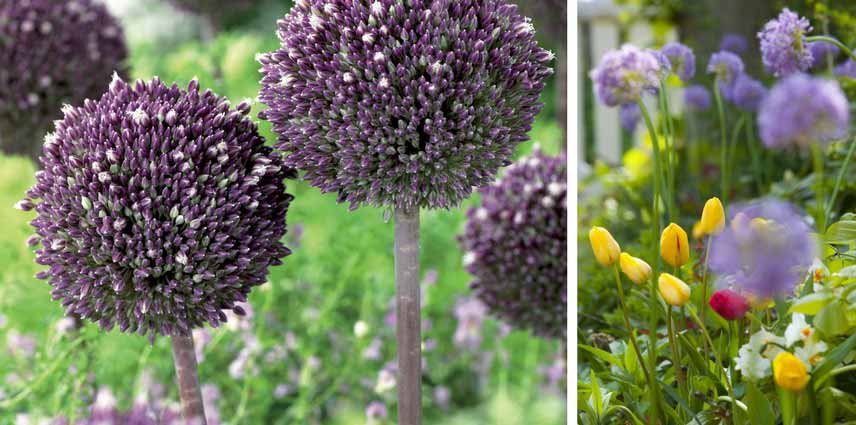
Plant Allium ‘Summer drummer’ with yellow-flowering perennials, Allium caeruleum with late yellow tulips ‘King of the Midi’
Pure punctuation and design
White varieties, such as Allium ursinum, Allium stipitatum ‘White Giant’, Allium karataviense ‘Ivory Queen, Allium ‘Mount Everest’, or A. ‘White Cloud’ complete a white garden and harmoniously combine with the metallic or green hues of hostas, lady’s mantle, or grasses like Stipa pennata or Pennisetum.
Ornithogalum saundersiae or Star of Bethlehem, Centaurea pulcherrima, Astilbe arendsii ‘Bumalda’ with long white plumes, asters, tricolour sage, and shrub peonies will effortlessly take turns at the heart of this bed that plays with monochrome.
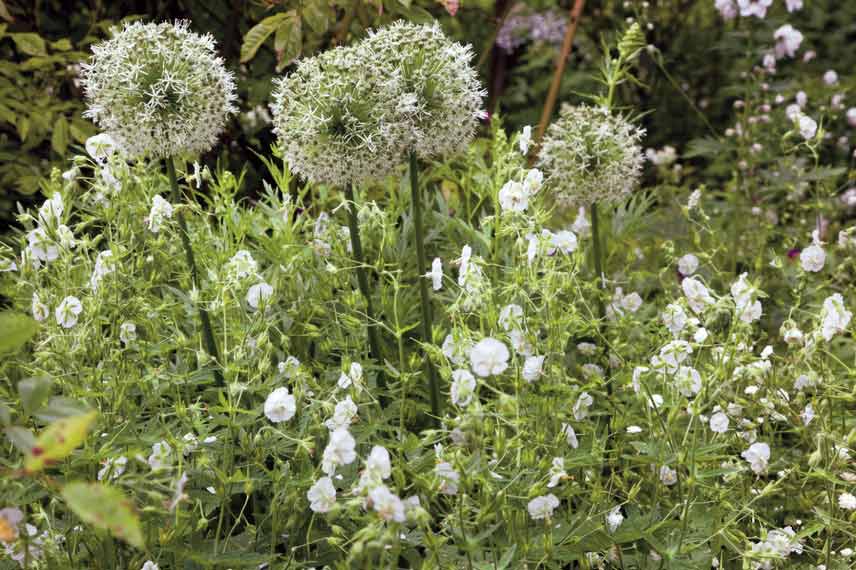
Geranium sylvaticum Album, Allium ‘Mount Everest’ (Photo: Biosphoto / NouN )
Their beautiful white umbels planted atop stiff, parallel stems like stakes will create a stunning effect alongside late-flowering roses, composing exquisite late spring scenes while providing a very structured foreground.
In a dry or fresh bouquet
Fresh decorative garlic flowers, which have good vase life, create beautiful, spectacular summer bouquets with simple, design lines when paired with Ornithogalum or more deconstructed with airy Gypsophila, old roses, peonies, and more.
The dried heads filled with well-ripened seeds are particularly graphic in dried bouquets when combined with Echinops or Nigella damascena, for example.

The beautiful solitary spheres in intense colours of alliums make very lovely cut flowers, here in a vase with lilies
- Subscribe!
- Contents































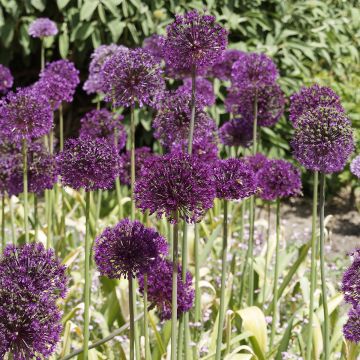
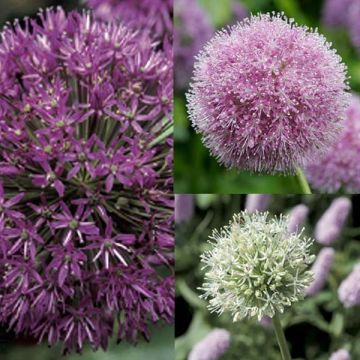
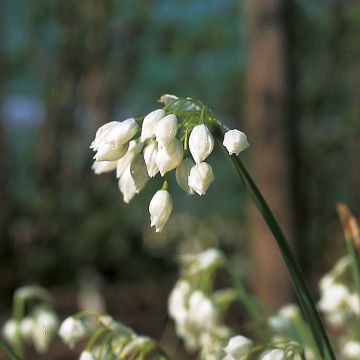

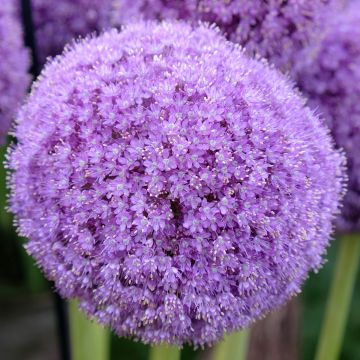
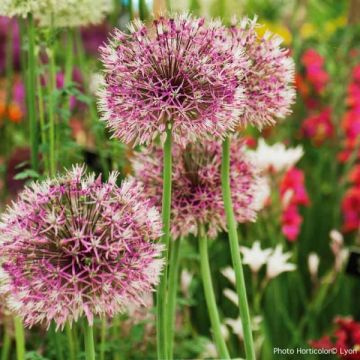
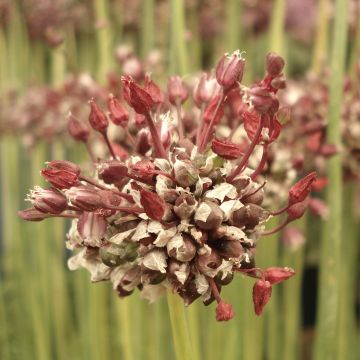
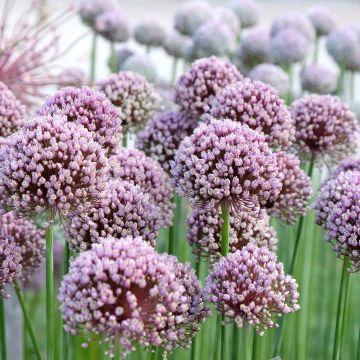
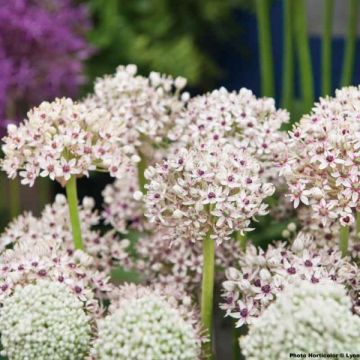
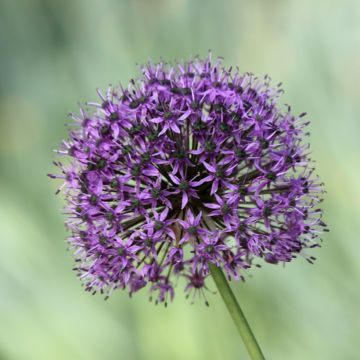
Comments